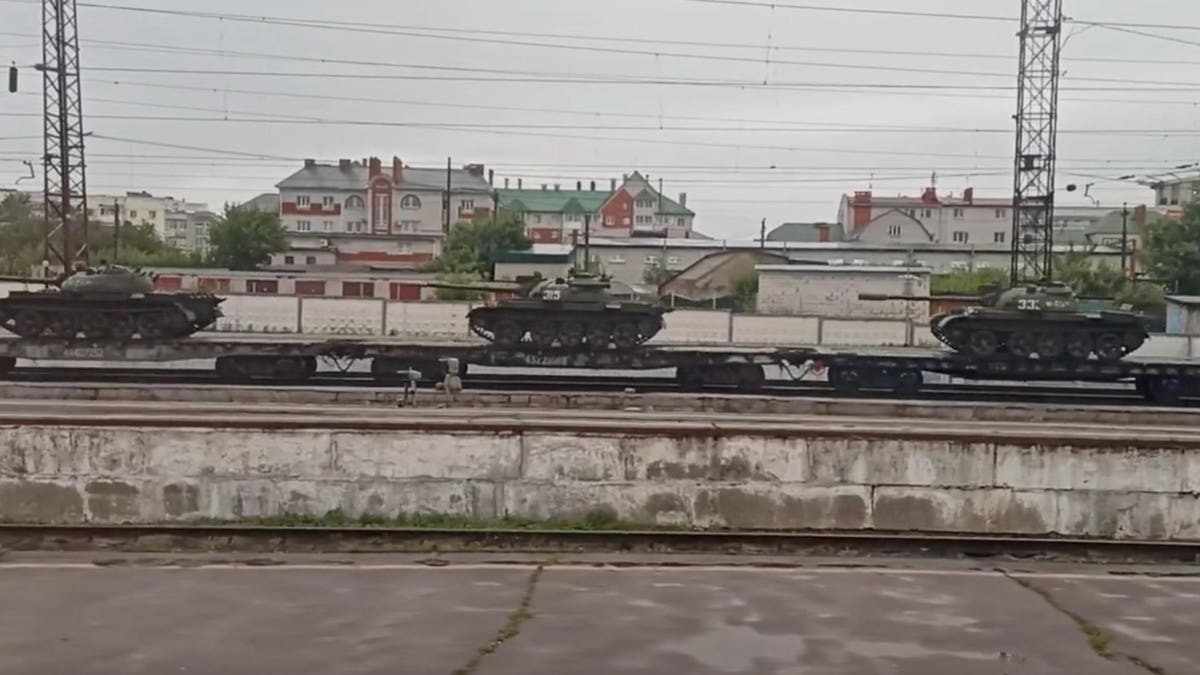A trainload of obsolete Russian army T-54/55 tanks, spotted traveling from southern Russia toward Russian-occupied Crimea, apparently has arrived in the strategic peninsula.
The tanks probably are destined to function as slightly-mobile, minimally-manned pillboxes—or, packed with explosives, as unmanned vehicle-borne improvised explosive devices.
Locals in Russia’s Voronezh Oblast, watching the 70-year-old tanks trundle past in late June, were unimpressed. “They’re ancient like mammoth’s crap,” one person comments in a video that recently circulated online.
The steady supply of potentially hundreds of war-reserve T-54/55s to Russian forces in southern Ukraine, four months after the Kremlin first began pulling the 1950s-vintage tanks from long-term storage, is the umpteenth reminder of the sheer violence of Russia’s 17-month wider war on Ukraine.
Russia has written off more than 10,000 of its best armored vehicles that outside observers can verify. That’s more vehicles than most of the world’s armies have in their entire inventories.
Deepening losses, combined with Russian industry’s inability to build more than a few dozen new tanks every month, have compelled the Kremlin to travel back in time, in a technological sense—first reactivating T-62 tanks from the 1960s, then restoring T-54/55s from the previous decade.
A 40-ton T-54 or slightly newer T-55 is hopelessly obsolete. With its thin armor, crude optics and minimally-stabilized 100-millimeter gun, it’s worse than useless in an intensive fight, especially at night. It’s a deathtrap for its four crew.
But the Russians generally aren’t deploying their T-62s, and especially their T-54/55s, for armored assaults as part of combined-arms formations. Instead, they’re positioning the tanks—sometimes with just a single person aboard—a few miles behind the line of contact and using them as crude howitzers.
It’s an expedient. “They make for an inefficient form of artillery,” Jack Watling and Nick Reynolds wrote about the aged tank-howitzers in a recent study for the Royal United Services Institute in London.
“Nevertheless, these engagements can often be made from positions that would not be viable for artillery, because of the tanks’ greater protection and thus reduced vulnerability to counterbattery fire,” Watling and Reynolds added.
The T-54/55 howitzers appear to be most popular with Russian units in southern Ukraine, where since June 4 Ukrainian forces have been conducting a grinding counteroffensive along several axes. Ukrainian losses along this front have been heavy—but Russian losses have been nearly equally heavy, if unofficial tallies of losses by independent analysts are even remotely accurate.
That’s weird, and a foreboding sign for Russian forces. A defending army historically tends to suffer many fewer casualties than attacking army does, as an attacker must expose himself while a defender can dig in.
But Ukrainian forces’ aggression, adaptability and precise artillery support seem to have helped their counteroffensive corps to defy historical precedent. All that is to say, Russian troops in southern Ukraine need all the reinforcements they can get. Even if those reinforcements are 70-year-old T-54/55s.
In eastern Ukraine, where the Ukrainians have launched a secondary counteroffensive, the T-54/55s have found a different purpose. Russian troops have been filling the old tanks with four or five tons of explosives, driving them to within sight of Ukrainian lines, jamming their controls in a forward gear then bailing out.
The idea is to roll the vehicle-borne IEDs onto Ukrainian positions then detonate them, either with a timed trigger or a well-placed missile or rocket hit. A VBIED with four or five tons of explosives can kill unprotected enemy troops from 500 feet away—and hurt them from 3,000 feet away.
The problem, of course, is that Ukrainian drones patrol the front lines. While there’s at least one verifiable example of a successful recent VBIED strike, there are many more examples of armored-vehicle IEDs that Ukrainian forces spotted with time to spare—and blew up with a rocket or an explosives-laden drone.
“Pack a tank with explosives, have a volunteer drive it, then jump off after pointing it toward the enemy,” Mark Hertling, a retired U.S. Army general, mused after hearing about the first Russian VBIEDs. “What a stupid way to conduct armored operations by the Russians.”
Stupid might actually be the wrong word. Desperate could be more accurate.
Read the full article here





